MINUTENFILME
Minutenfilme are extremely short works in which Kluge delivers ironic commentary on historical events.
In some of his Minutenfilme, Kluge works from existing images; found footage which he subsequently heavily condenses. In this way, the original material of say a few hours is reduced to a film of roughly one minute. This series consists of six works in which Kluge often reveals the subject and the utilised (technical) process in the title of the work.
This is for instance the case with Fünf Stunden Parsifal in 90 Sekunden, in which he condenses Wagner’s opera (in a version by the late German writer and director Einar Schleef) from an hour-long spectacle into a work of exactly ninety seconds. Aside from the original work and its performance, the preparation of the opera, the scenography, and the architecture of the theatre are included in the film as well. Kluge didn’t compress the soundtrack; he chose to play a fragment from Parsifal.
There is more music in Der Schwedische Mozart, a work about the German composer and royal bandmaster Joseph Martin Kraus, often nicknamed ‘the Swedish Mozart’. A young man is seen playing the piano in front of a grotesque video background showing a night storm. He brings Öfver Mozarts död in E flat mayor, a score from 1792 which Kraus dedicated to his great example, Mozart. Neonrörhen des Himmels shows the northern lights in a very brief span of time, preceded by the caption ’60.000 Jahre vor Chr.’. Accompanied by esoteric music, the work is reminiscent of the trifles TV stations would air during technical breaks or uncomfortable pauses between two programmes.
An Vertov und Eisenstein unites two pioneers of the Soviet cinema for a short span of time: Dziga Vertov and Sergej Eisenstein. Kluge speeds up and overlaps fragments from their classics, respectively The man with the camera and The Battleship Potemkim. The medium through which this jumble of images is shown is not the cinema screen, but a spherical design television from the seventies. The object of the television as a medium is also central to 100 Jahre Deutscher Rhein in 60 Sekunden. Here, it spews out extremely condensed images of festivities and fireworks in an anonymous German city on the Rhine.
Finally, Learning Processes with a Deadly Outcome – War & Theatre bears the same title as Kluge’s novel published in 1973. In it, he tells the story, with much humour and irony, of a community in the future that lives underground after a devastating war. In this little film, compressed images of a theatre performance –again shown through a (this time broken) television set – are combined with fragments of, among others, war and science-fiction movies.
In his Minutenfilme, Kluge does not only develop inventive and funny processes which provide pleasant, short viewing experiences. His works are grounded in social criticism and dry irony. In every work Kluge expresses his personal thoughts on events and figures from his national ‘history’.
In some of his Minutenfilme, Kluge works from existing images; found footage which he subsequently heavily condenses. In this way, the original material of say a few hours is reduced to a film of roughly one minute. This series consists of six works in which Kluge often reveals the subject and the utilised (technical) process in the title of the work.
This is for instance the case with Fünf Stunden Parsifal in 90 Sekunden, in which he condenses Wagner’s opera (in a version by the late German writer and director Einar Schleef) from an hour-long spectacle into a work of exactly ninety seconds. Aside from the original work and its performance, the preparation of the opera, the scenography, and the architecture of the theatre are included in the film as well. Kluge didn’t compress the soundtrack; he chose to play a fragment from Parsifal.
There is more music in Der Schwedische Mozart, a work about the German composer and royal bandmaster Joseph Martin Kraus, often nicknamed ‘the Swedish Mozart’. A young man is seen playing the piano in front of a grotesque video background showing a night storm. He brings Öfver Mozarts död in E flat mayor, a score from 1792 which Kraus dedicated to his great example, Mozart. Neonrörhen des Himmels shows the northern lights in a very brief span of time, preceded by the caption ’60.000 Jahre vor Chr.’. Accompanied by esoteric music, the work is reminiscent of the trifles TV stations would air during technical breaks or uncomfortable pauses between two programmes.
An Vertov und Eisenstein unites two pioneers of the Soviet cinema for a short span of time: Dziga Vertov and Sergej Eisenstein. Kluge speeds up and overlaps fragments from their classics, respectively The man with the camera and The Battleship Potemkim. The medium through which this jumble of images is shown is not the cinema screen, but a spherical design television from the seventies. The object of the television as a medium is also central to 100 Jahre Deutscher Rhein in 60 Sekunden. Here, it spews out extremely condensed images of festivities and fireworks in an anonymous German city on the Rhine.
Finally, Learning Processes with a Deadly Outcome – War & Theatre bears the same title as Kluge’s novel published in 1973. In it, he tells the story, with much humour and irony, of a community in the future that lives underground after a devastating war. In this little film, compressed images of a theatre performance –again shown through a (this time broken) television set – are combined with fragments of, among others, war and science-fiction movies.
In his Minutenfilme, Kluge does not only develop inventive and funny processes which provide pleasant, short viewing experiences. His works are grounded in social criticism and dry irony. In every work Kluge expresses his personal thoughts on events and figures from his national ‘history’.
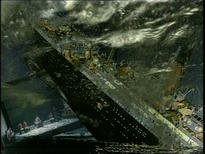
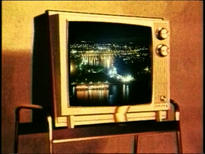
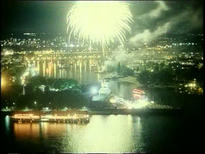
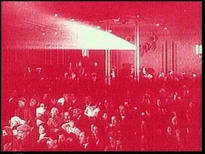
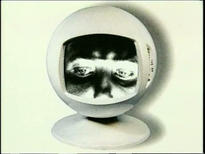
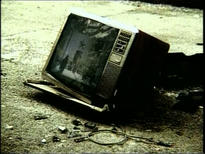
- Formaat DIGITAL FILE(DIGITAL FILE)
- Kleursysteem PAL
- Kleur col.
- Jaar 2006
- Duur 00:07:00
-
Kunstenaars
-
EVENEMENTEN